14
Ruined Blackhouse
29 September 2001
West Coast of Barra, Scotland
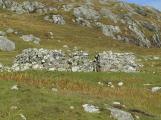 Credits:
Credits:
Highland Village Museum
15
Deep set window in the Blackhouse with a quern for grinding grain
1 October 2001
Highland Folk Museum, Newtonmore, Scotland
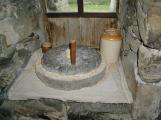
16
Windows were not known in early times. Sometimes a piece of glass was inserted in the roof as a sort of skylight. Later buildings may have had a window deeply set into the wall.
17
Inside blackhouse, Baile Gean site, Highland Folk Museum
27 September 2001
Newtonmore, Scotland
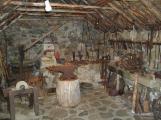 Credits:
Credits:
Highland Village Museum
18
The Barra people were not a material people, their possessions were of necessity. A chain hung from the rafters over the firepit and pots or griddles were hung from the chain to cook the food. The family slept on the floor near the fire and seats (if they had them) were low to the ground to stay out of the smoke as much as possible. The thick walls of the home kept the heat in and wind out.
19
LIfe in the Blackhouse
25 October 2007
Highland Village Museum, Victoria County, NS
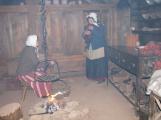
20
The fire was built on the floor in the centre of the building. As the roof material was thatch, the smoke was left to filter out through the roof or a small hole was left in the roof for this purpose. The living area was smokey and the roof sooty. Each spring the roof material was changed when the cattle were taken to the summer pasture and the family left the home.
21
Castle Bay from the road to Vatersay
29 September 2001
Castle Bay, Barra, Scotland
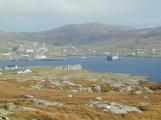 Credits:
Credits:
Highland Village Museum
22
Clach-Cuaich, a hand grinder for grain
18th Century, circa 1780
Highland Folk Museum, Newtonmore, Scotland
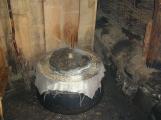
23
The hand grinder was an important tool for the Gael. He could grind the oats for porridge and other food. It was one of the items reported to have been taken with them to the new world.
24
Ruined blackhouse
29 September 2001
South Coast, Barra, Scotland
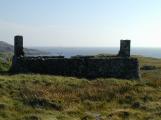 Credits:
Credits:
Highland Village Museum
25
By the end of the 18th century there were changes in the way of life for the people of Barra. The reasons people left Barra were varied. Farming methods changed and land holdings were made smaller to accomodate animals. Making potash from kelp, which gave the people cash to pay rents as they were paid to produce it, became less important with the discovery of barilla and its subseguent importation. Others from Barra, like Donald Og MacNeil a soldier, had traveled to North America and brought back stories of North America and the land available there. Also, agents began to arrange passage for those who wanted to go. Some landlords arranged passage for their tennants as they wanted the land for raising sheep. Other Gaels wanted to leave for religious reasons. Barra had remained mostly Catholic and as such were at odds with the mainland of Scotland. By and large, the desire for a better life for themselves and their children promted many Barra people to set sail for Cape Breton.
26
Sheep graze on the Island of Barra
29 September 2001
Barra, Scotland
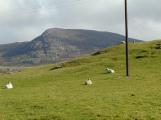
27
Between 1772 and 1821, it is estimated that 900 people left the islands. For some of them, this was the chance to own their own land and practice their religion in peace. Hearts were heavy but hope for the future was great.

 Credits:
Credits: Credits:
Credits:



